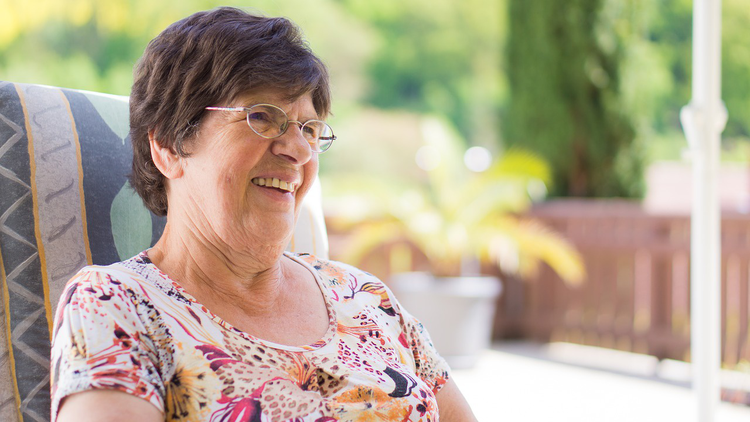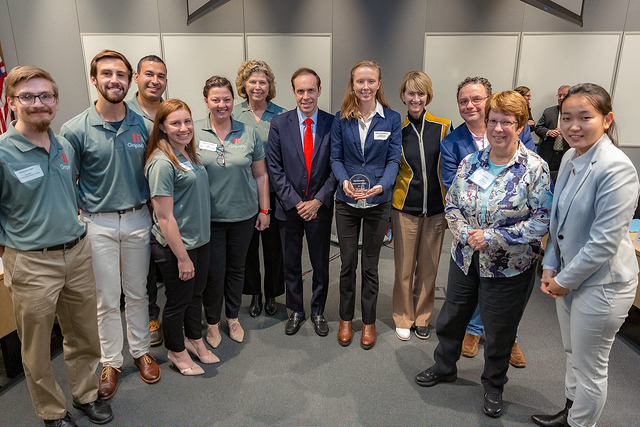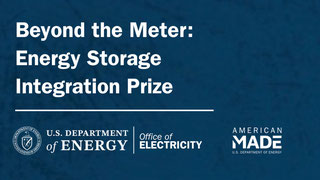This challenge is open to all undergraduate and graduate students attending a New York college or university. Faculty may participate on a team with one or more students.
The Problem
Where do you want to live as you age? If you’re like the vast majority of older adults, you expect to remain in your home. But what happens if you are no longer able to perform the normal activities of daily living, such as bathing or getting dressed? How will you get help if you live alone? Most people do not consider these issues until they are faced with them and struggle to confront their changing needs. This challenge requires you to face these issues, today. Your innovation could make the difference to someone fighting to maintain independence in their home or to a stressed caregiver providing daily assistance to a loved one while maintaining a full-time job.
The reality of life is that we can all expect to be a caregiver or a care recipient at some point in our lives, and many of us will play both roles. The time to create tomorrow’s solutions is now.
The Challenge
The New York State Department of Health is looking for innovators to develop prototypes that will assist aging New Yorkers and their caregivers in completing activities of daily living (ADLs). ADLs include:
- Eating: Being able to feed yourself by getting food and drink from a container into your mouth.
- Bathing: Being able to get into and out of a tub or shower and wash your body by yourself.
- Dressing/Grooming: Being able to put on and take off any necessary items of clothing and manage your personal hygiene.
- Toileting: Being able to get to and from the toilet, get on and off the toilet, and clean yourself.
- Transferring: Being able to get into and out of a bed, chair or wheelchair.
- Mobility: Being able to get around your home.
Innovators are required to submit a written proposal of their prototype by April 30, 2018. Additionally, selected innovators will be asked to submit a final project by November 1, 2018. By November 15, 2018, five finalists will be invited to make a live demonstration of their prototypes during the week of November 28, 2018.
The Prize
The New York State Department of Health has committed $50,000 in total prize money!
What Can You Do Right Now?
- Share this challenge on social media using the icons above. Show your friends, your family, or anyone you know who has a passion for discovery.
- Start a conversation in our Forum to join the conversation, ask questions or connect with other innovators.
The Prize
The New York State Department of Health has committed up to $50,000 in prize money!
- Up to 5 finalists will receive an award of up to $5,000 dollars
- 1 Grand Prize winner will receive a prize of at least $25,000 dollars
Timeline
Innovators are required to submit a written proposal of their prototype by April 30, 2018. Additionally, selected innovators will be asked to submit a final project by November 1, 2018. By November 15, 2018, five finalists will be invited to make a live demonstration of their prototypes during the week of November 26, 2018.
Pre-Registration Open November 22, 2017
Open to Submissions January 4, 2018
Phase 1 Submission Deadline April 30, 2018
Judging Opens May 1, 2018
Semi-Finalist Announcement May 15, 2018
Phase 2 Submission Deadline November 1, 2018
Finalist Announcement November 15, 2018
Live Demonstration Week of November 26, 2018
Winner Announcement By December 28, 2018
Live Demonstration Event
During the week of November 26, 2018, the New York State Department of Health will host a public event featuring up to 5 finalists selected by the Judging Panel. Finalists will have the opportunity to make a 15-minute presentation demonstrating or highlighting the impact of their prototype on Activities of Daily Living for the Aging Population. A 15-minute Q&A session led by the Judging Panel will immediately follow.
Judges will score competitors on the Judging Criteria below. Following the Live Demonstrations, judges will reconvene to determine one Grand Winner.
Judging Criteria
Metric | Description | Weight |
Innovation | How does the prototype differ from existing solutions addressing this problem? How is the solution innovative or novel? Strong preference will be given to technologies that provide physical assistance. | 30% |
Impact | Does the solution consider the improvement in the quality of life for aging individuals, caretakers, and the community of New York overall? Does the entrant state the improvement, for whom, and how the solution will increase quality of life? | 20% |
Usability | How likely will this technology be adopted into the daily lives of the aging population? Does the proposal thoughtfully consider the implications of user adoption, including costs, technical setup requirements, troubleshooting, etc.? | 20% |
Implementation | Does the submission demonstrate that the tool/resource can be commercialized? Is the competitor interested in pursuing this opportunity further? | 15% |
Feasibility | In what development stage is the prototype? A concept, minimum viable product, manufacturing, pre-revenue? Innovators can submit a Concept, but the Concept must be beyond the Concept Stage at the time the Updated Proposal is due, on November 1, 2018. If the proposal has not moved beyond the Concept Stage, it will be removed from consideration. Is the robustness of the solution's proposal supported by proof or demonstration of concept, pilot/test trials, and/or simulations to substantiate that the technology is or will be operable and feasible? | 15% |
Submissions
To be accepted into the competition for judging, submissions must, at a minimum:
- Provide an explanation of the concept behind the prototype;
- Describe which ADL or ADLs the prototype addresses and how it can be used
- Eating: Being able to feed yourself by getting food and drink from a container into your mouth.
- Bathing: Being able to get into and out of a tub or shower and wash your body by yourself.
- Dressing/Grooming: Being able to put on and take off any necessary items of clothing and manage your personal hygiene.
- Toileting: Being able to get to and from the toilet, get on and off the toilet, and clean yourself.
- Transferring: Being able to get into and out of a bed, chair or wheelchair.
- Mobility: Being able to get around your home.
- Describe the expected social impact and how the technology will help people age in place;
- Identify and compare the prototype to any existing technologies available in the marketplace;
- Provide video of the prototype that demonstrates how the technology can assist an older adult with one or more ADLs;
- Detail the usability and implementation of the proposed technology; and
- Provide the methodology used to develop the technology.
Submission Forms:
All submissions must be submitted via HeroX.com. To begin your submission, click ACCEPT CHALLENGE above.
Phase 2 Submission:
The phase 2 submission form will be available from May 15 to November 1, 2018. Based on the evaluation of the Phase 2 submissions, up to five finalists will be invited to the Live Demonstration Event. At the Live Demonstration event, innovators must be able to demonstrate some functionality of a working prototype and describe the pathway to commercialization. Any submissions still at the concept stage will not be considered.
You may answer the following questions using your answers from the Phase 1 submission form or you may provide a revised answer. Character limits include spaces.
- Team: Please provide a current team roster with each team member’s full name, student status (undergraduate student, graduate student, or faculty member), school and field of study. Please indicate the team lead and if any team members were added or removed (2000 characters)
- Team: Are you or any member of the team an employee representative, dealer, or agent of the New York State Department of Health? (Yes/No)
- Have you created a prototype of your technology? (Yes/No)
- Development: Describe what progress has been made on your prototype since the April 30th submission deadline (1000 characters)
- Development Forecast: Define the future development milestones that are achievable prior to the live demonstration event during the week of November 26. (1000 characters)
- Please provide a PDF document describing your prototype and a video showing how your prototype works.
- • The PDF document should be no more than 5 pages and include photographs, diagrams, and/or illustrations with a brief summary or description to clearly indicate how your technology works and how it is used by an older adult and caregiver, if applicable.
- • The video should show how your technology can assist an older adult with the activities of daily living that your prototype impacts. Upload your video to Youtube or Vimeo and then copy and paste the link here. While your video may be unlisted, please ensure it is not password protected.
- Assistance: Please describe how your prototype aims to assist older adults? Strong preference will be given to technologies that provide physical assistance. (1000 characters)
- Technology: What core technology does your prototype leverage in order to be functional? (1000 characters)
- Activities of Daily Living (ADLs): Select all Activities of Daily Living (ADLs) that your technology would impact.
- Eating: Being able to feed yourself by getting food and drink from a container into your mouth.
- Bathing: Being able to get into and out of a tub or shower and wash your body by yourself.
- Dressing/Grooming: Being able to put on and take off any necessary items of clothing and manage your personal hygiene.
- Toileting: Being able to get to and from the toilet, get on and off the toilet, and clean yourself.
- Transferring: Being able to get into and out of a bed, chair or wheelchair.
- Mobility: Being able to get around your home
- ADL Impact: Describe how your technology would impact each selected ADL. (5000 characters)
- Ensure you address each ADL you selected in the question above. For a technology to impact an ADL, it must *directly* support in the completion of the task.
- Caregiver Impact: If required, describe how a caregiver might interact with your prototype. How would this impact the quality of life for caregivers in New York? (500 characters)
- Consider if a caregiver is required in the initial setup and/or use of your technology.
- Competitive Analysis: List all competitive or related technologies. Identify and compare your prototype to these existing technologies. (5000 characters)
- Ensure you consider direct and indirect competitors. Emphasize how your technology is different from your competitors.
- Innovation: Our judges are prioritizing cutting edge technology. Make your pitch as to why you should be considered as a top Innovator for this competition. (1000 characters)
- Adoption Rate: Thoughtfully address how the Aging Population will adopt your technology into their daily lives. Discuss the potential barriers and mitigation strategies that exist with the adoption of your technology. (1000 characters)
- New York Community Impact: It is 2030. Imagine that your technology has been widely adopted and implemented. Envision and describe how New York as a community would be impacted. (1000 characters)
- Related Industry: Does your prototype rely on technology that has been implemented in an unrelated industry? If so, describe how it may be useful to apply for assisting the Aging Population. (1000 characters)
- Implementation: Knowing what you know now, update your plan to commercialize your prototype. Wherever possible, list: required partnerships, budget, timeline, necessary resources, FDA approvals, manufacturing needs, etc. (5000 characters)
Eligibility
The challenge will be open to New York’s college and university communities, including both undergraduate and graduate students, including students that have graduated during the 2017-2018 academic year. Faculty may participate if they are part of a team with one or more students. It excludes employee representatives, dealers, and agents of the New York State Department of Health. Innovators may participate individually or in teams. All teams must identify a lead team member to whom communication can be directed.
Submissions must be made in English. All challenge-related communication will be in English. Submissions must be made online (only), via upload to the HeroX.com website, on or before the stated deadlines. All uploads must be in PDF format. No late submissions will be accepted.
No specific qualifications or expertise in working with aging or long-term care is required. Innovators must comply with all terms of the Challenge-Specific Agreement.
By the April 30th Submission Deadline, innovators must have the capacity to design a prototype of their idea. At the Live Demonstration event, innovators must be able to demonstrate some functionality of a working prototype and describe the pathway to commercialization. Innovators can submit a Concept, but the Concept must be beyond the Concept Stage at the time the Updated Proposal is due, on November 1, 2018. If the proposal has not moved beyond the Concept Stage, it will be removed from consideration.
Intellectual Property
All intellectual property rights will remain with the innovator, in accordance with the terms provided in the Challenge-Specific Agreement.
Additional Information
- By participating in the challenge, each competitor agrees to submit only their original idea. Any indication of "copying" amongst competitors is grounds for disqualification.
- All applications will go through a process of due diligence; any application found to be misrepresentative, plagiarized, or sharing an idea that is not their own will be automatically disqualified.
- All ineligible applicants will be automatically removed from the competition with no recourse or reimbursement.
- No purchase or payment of any kind is necessary to enter or win the competition.
- Void wherever restricted or prohibited by law.
- Teams may be required to provide personal identifying information to receive a monetary prize award.










